The Agarita is an evergreen shrub, concentrated most densely in Texas but spreading through New Mexico, Arizona, and south to Mexico.
It's also one of my favorite Texas native plants in my own landscape.
Agarita is most known for its very prickly gray-green leaves, which in nature protect other plants so that they can establish themselves before they are nibbled away. The Agarita is wonderfully fragrant in Spring with yellow flowers and produces berries that feed birds (or humans!) in late Spring and early summer.
The Agarita is a resilient, drought-resistant understory evergreen that, while prickly, can significantly benefit your Texas Native landscape.
Common Name(s): Agarita/Agarito, Wild Currant, Algerita.
Height: 3-6 ft., can reach 8-10ft
Soil Conditions: Rocky, dry soils. Agarita is most commonly found on the limestone of the Edwards Plateau throughout the Texas Hill Country.
Water: Low
Light: Full Sun - Dappled Shade. While an understory shrub, it prefers pockets and edges where it can get significant sun.
Family: Berberidaceae (Barberry Family)
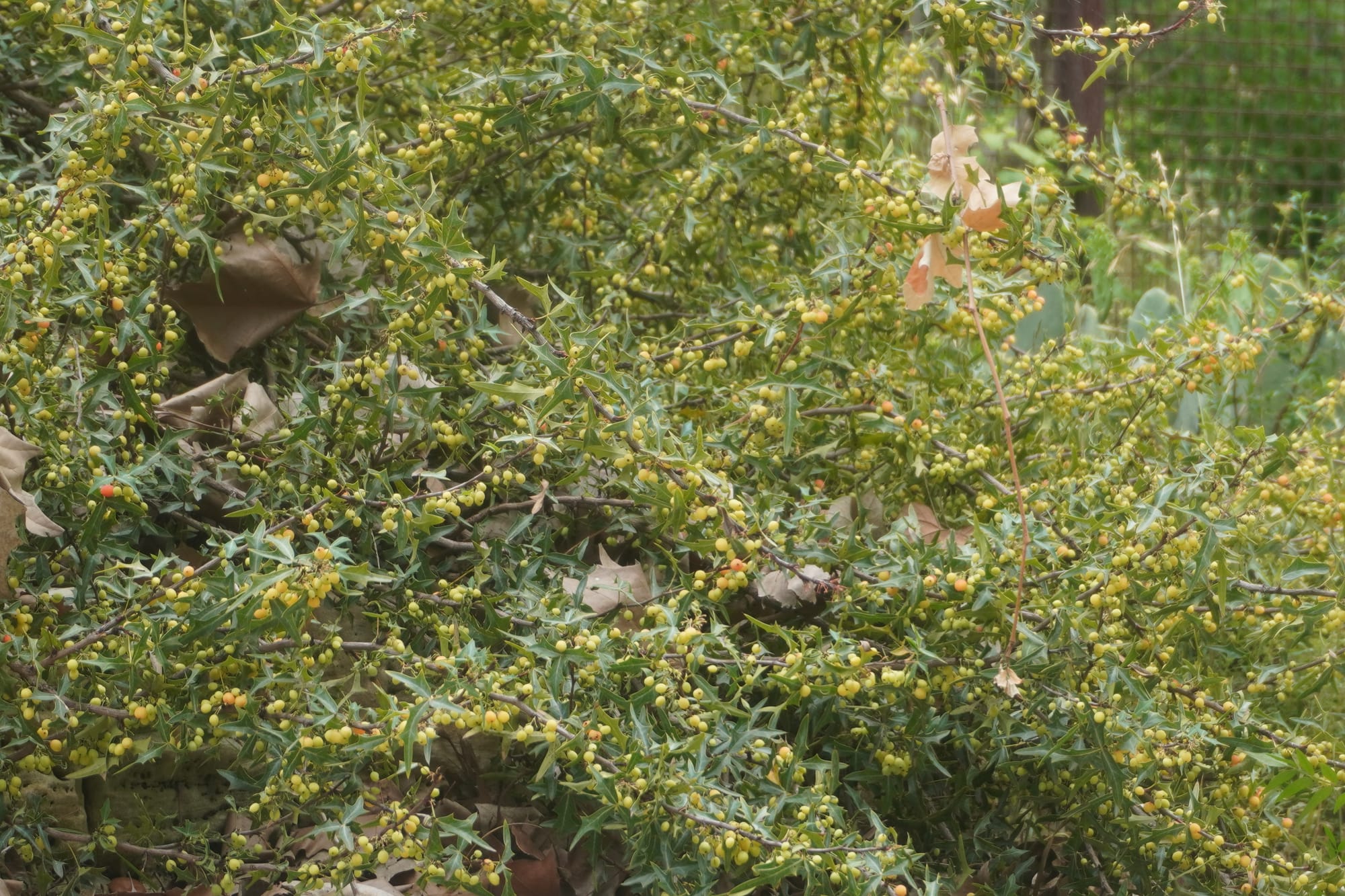




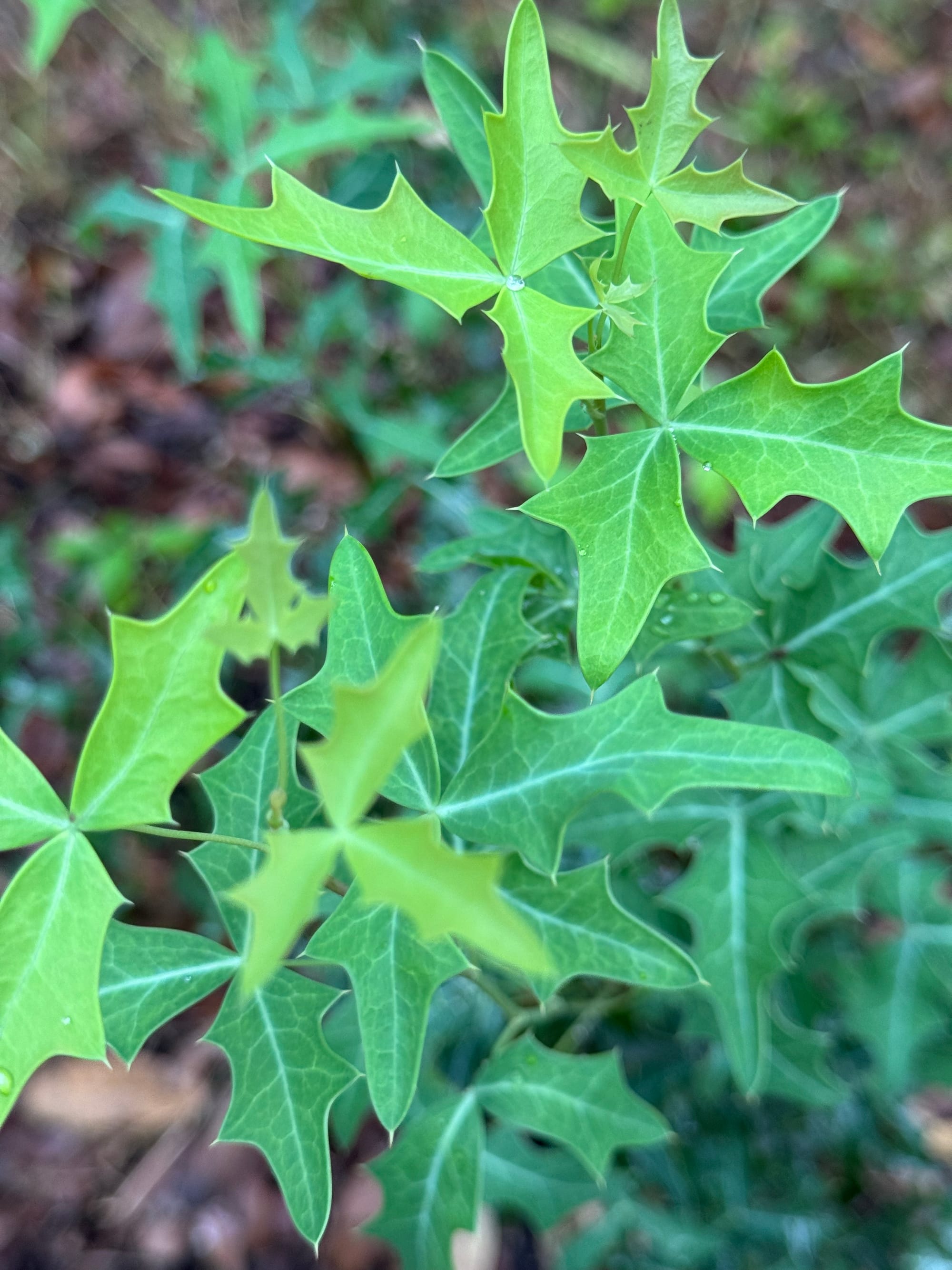
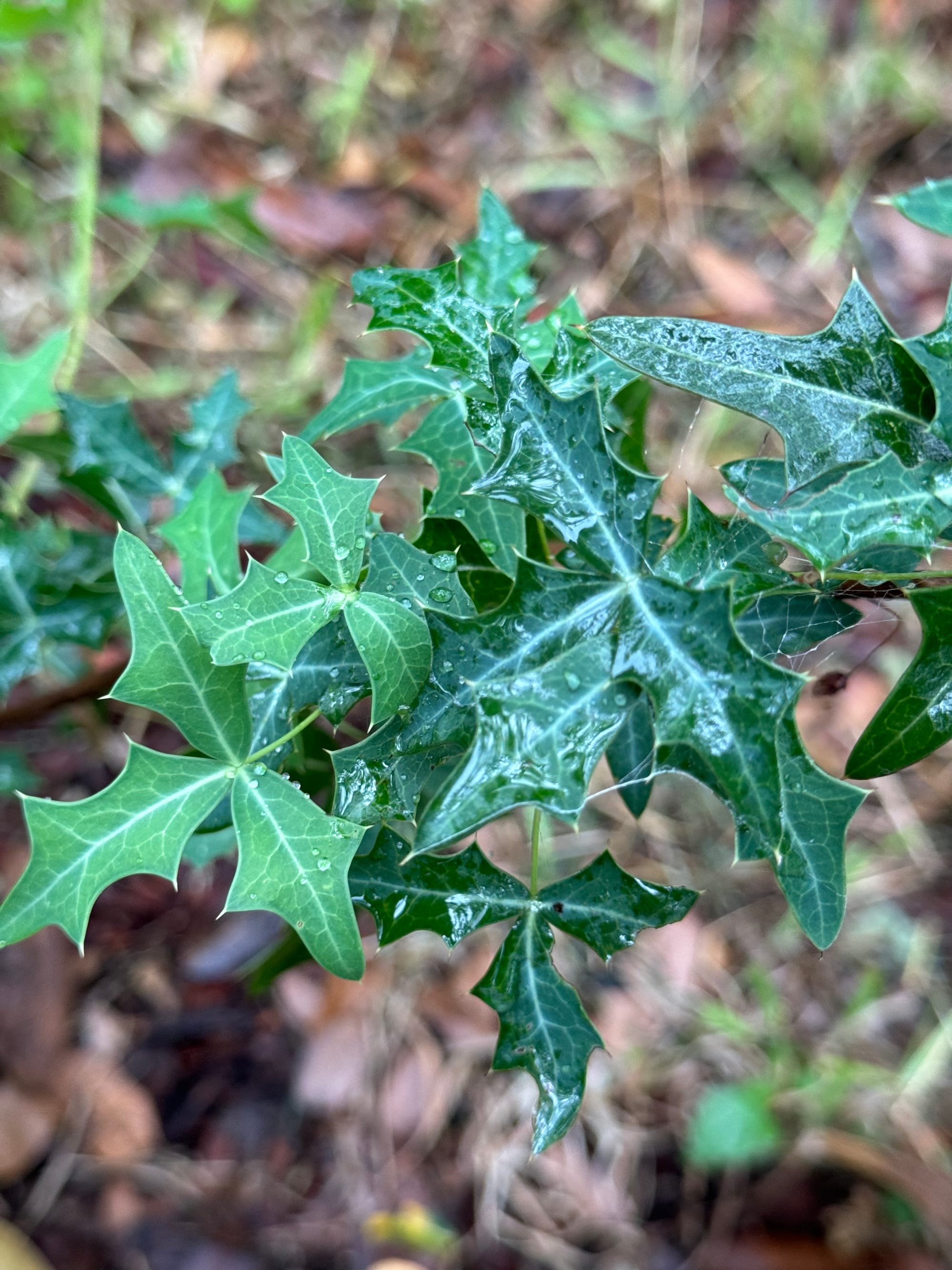
Distribution:
Where is Agarita Native?
The Agarita is highly concentrated in the South Central Texas area, but observations of It have been made as far west as New Mexico and central Arizona, as far north as the Texas panhandle, and as far South as central Mexico.
While an understory shrub, you’ll find Agarita near trails and clearings. This is because while it can do well partly shaded, it does love the sun. This is why it gravitates to edges where it can occasionally get some good light while still underneath larger plants in the understory.
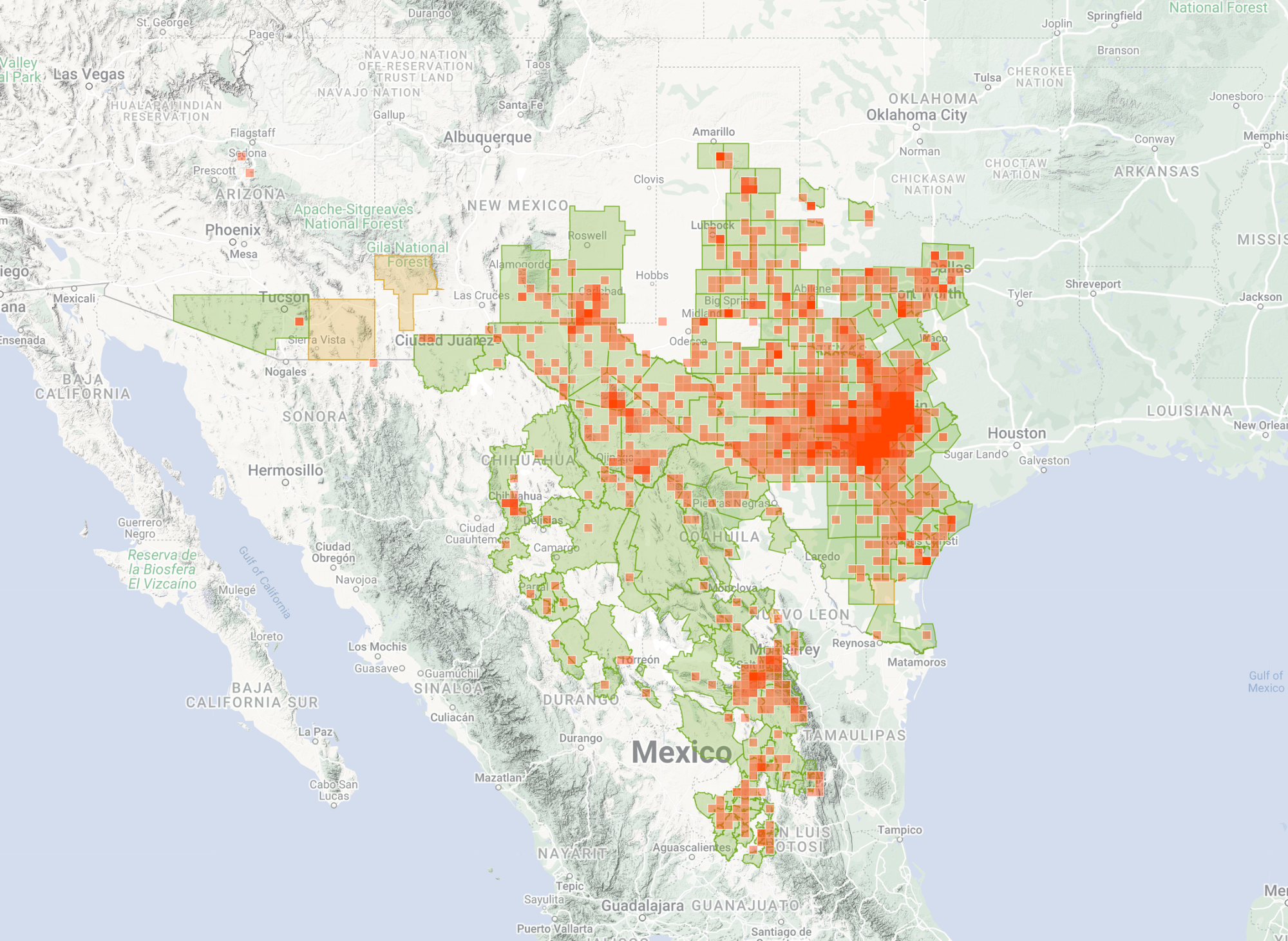
The Benefits of Agarita:
Here are the benefits of Agarita both for your landscape and as it’s found in its native ecosystem.
For Your Landscape:
Early (Fragrant) Spring Blooms — As mentioned, the Agarita is one of the earliest spring bloomers. The yellow blooms in spring have a wonderful smell. Walk any trails in the San Antonio area where Agarita is abundant in early spring (e.g., Phil Hardberger Park); the smell of Agarita blooms takes over! You’ll enjoy having the attractive, sweet-smelling flowers in your yard.
Attractive — I think the Agarita is an attractive plant and offers visual interest, of course, in the early spring with its golden yellow blooms and thereafter when it can be packed full of bright red berries. Also, it won't go bare in the winter as an evergreen.
Fencing — Agarita is seriously prickly! While you won't be picking any spines out of our fingers like you would touching a Texas Prickly Pear (unless spineless!), stepping barefoot on a fallen agarita leaf by surprise is quite intense (speaking from experience). Likewise, as it grows larger and more dense, it's quite impenetrable. Natural barbed wire, almost!
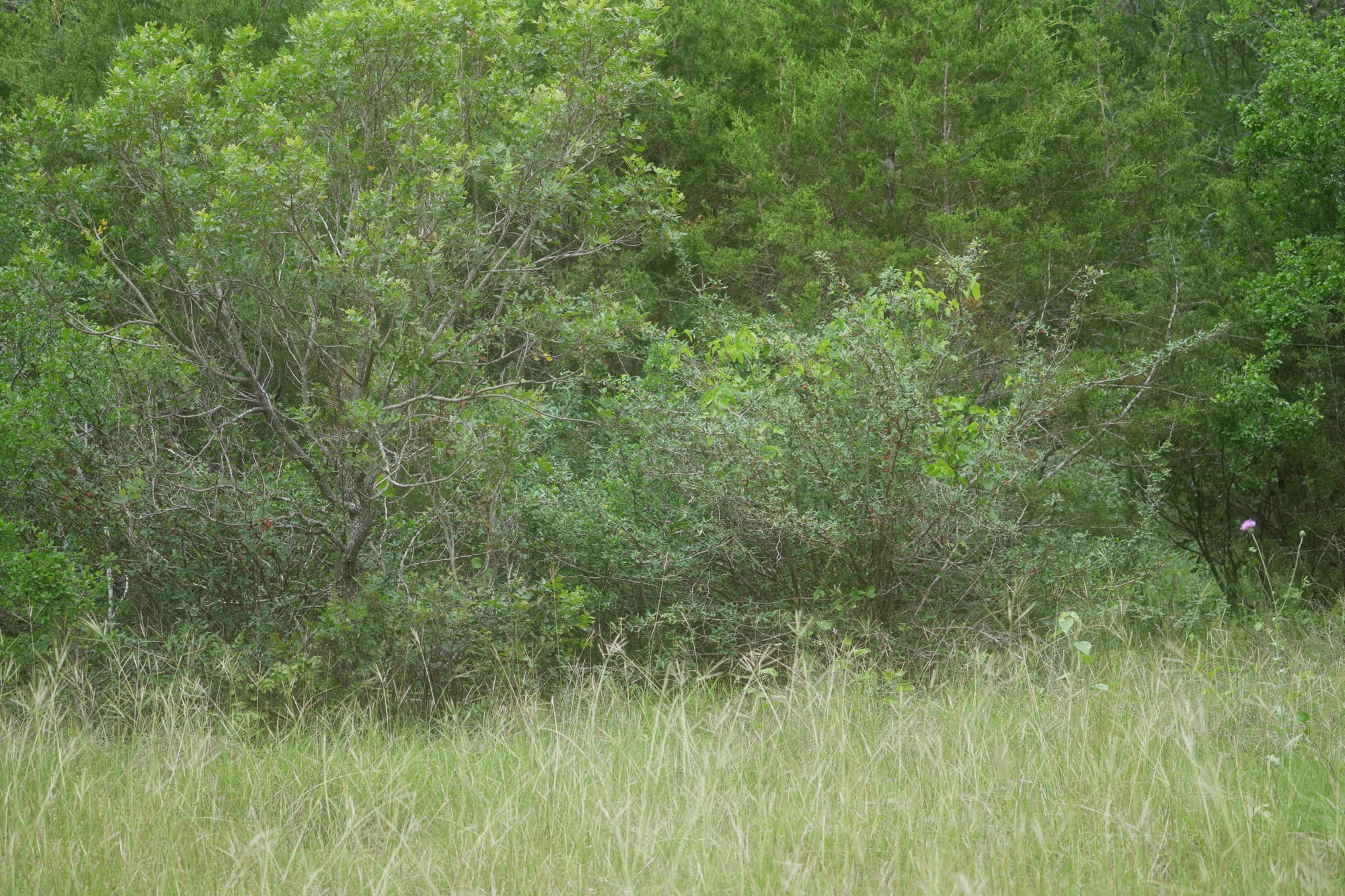
For Wildlife:
Protection—Because of the sharp leaves on the Agarita, it offers protection to younger plants so they can get established before they are eaten by other wildlife. This is why the Agarita is considered a “nurse” plant. It saves many young saplings in the central Texas area from the abundant deer.
Shelter—The Agarita can also offer protection to smaller mammals, birds, etc., as a mature Agarita plant can offer excellent cover. Also, because it’s evergreen in nature, that cover extends year-round through winter. Like the Northern Mockingbirds, birds that like to nest closer to the ground will use the Agarita for protection.
Food Source—Agarita's berries in late spring/early summer can be a food source for songbirds, or for me and you! They are a bit tart but still very sweet. The fruits are ripe, typically in late May or early June.
Nectar Source—As one of the earliest spring blooms, Agaritas are an important source of nectar for bees and many other insects as we emerge from winter.
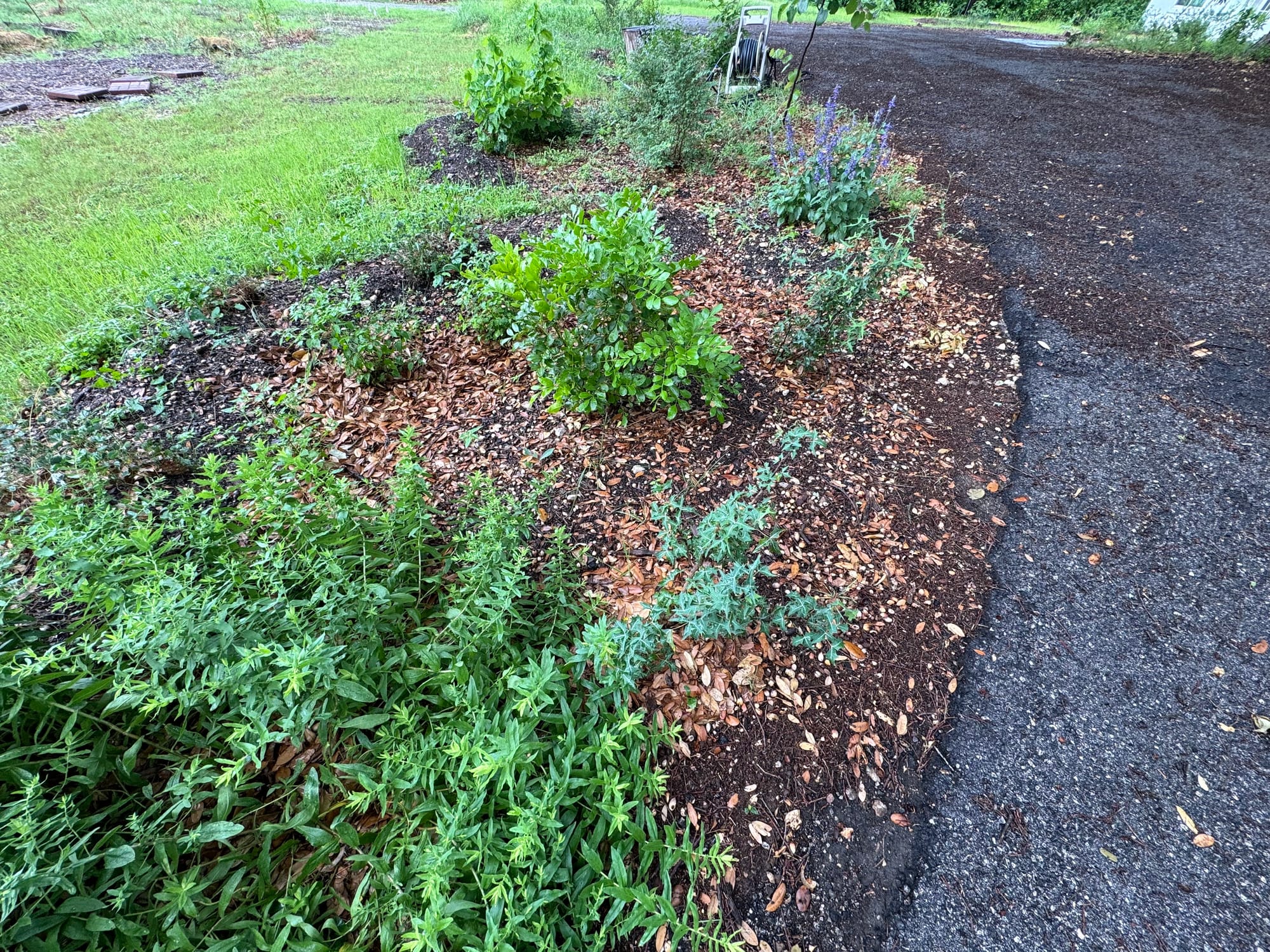

Two of my second year Agarita Plantings. Matched with Texas Mountain Laurel, Chili Pequin, Fall Aster, and Indigo Spires
Planting & Care:
Where is the best place to plant an Agarita?
- Understory Planting under Established Trees - Plant under your Live Oaks! Agarita can tolerate partial shade provided by the canopy of larger trees. Solve that pesky problem of figuring out what to plant under your Live Oak trees, Ashe Junipers, or Cedar Elms. But, be strategic and watch where you do get pockets of early morning or evening light when the sun is lowest in the sky. According to Jill Nokes, in her book How to Grow Native Plants of Texas and the Southwest, Agarita will "form larger more well-shaped plants in full sun."
- Use along the edges of your property as a Living Fence. Agarita's dense and thorny nature makes it an excellent choice for a natural barrier that discourages pass-throughs and can provide a habitat for local wildlife. Unfortunately, stray dogs are a major problem in our area, over time, we'll most likely use Agarita to fill in gaps in our perimeter plantings.
- Plant in sunnier edges of the understory. While Agarita can tolerate shade, it performs best in sunnier locations with ample light. This encourages better flowering and fruiting, which is vital for attracting birds, other pollinators, and foragers!
- Ideal in rocky, limestone-rich soils (if you have them). Native to the Texas Hill Country, Agarita is well-adapted to thin, rocky soils. However, I live on the Blackland Prairie, with thick clay soils and our Agaritas are doing fine.
- Plant in drier, hotter parts of the garden. Agarita is xeric, meaning it thrives in conditions with little moisture. That’s why in it’s distribution (above) you’ll see Agarita observed mostly San Antonio and West, as San Antonio might be the “wettest” the Agarita can stand (≈32 inches rain per year).
- Place higher on slopes away from water accumulation. Position Agarita where water is less likely to pool, given that it prefers drier conditions. For example, with the berms n’ basins we constructed for water retention, I placed my Agaritas higher up on the slope to minimize any water pooling around their roots in major rain events.
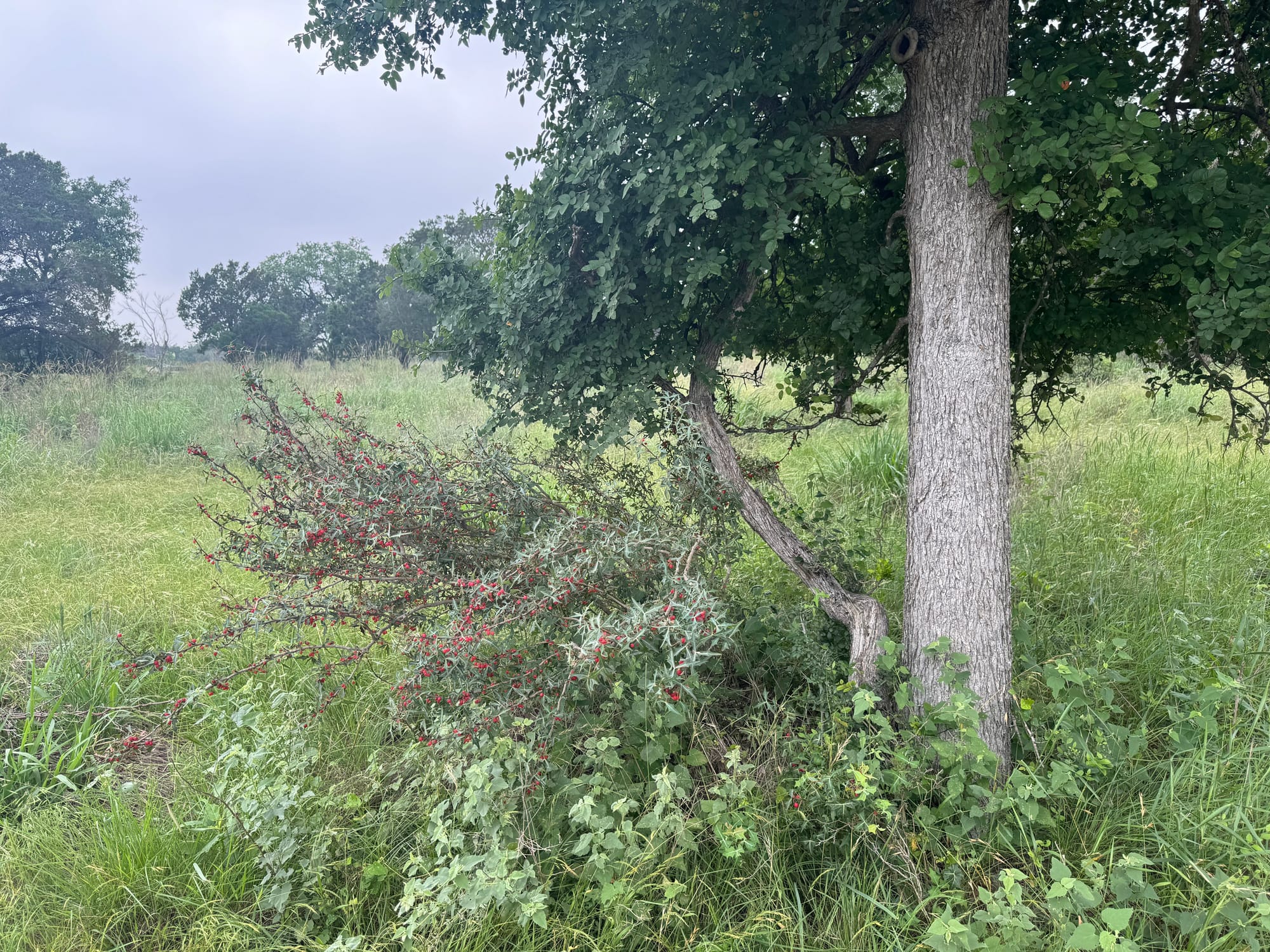
How do you care for an Agarita?
Care/Maintenance: You should be fine as long as you plant your Agarita in drier conditions that drain well! It’s a freeze-hardy, resilient plant. For folks with predominately clay soils (like us) I had to be a little bit more mindful about where I put it. I've planted Agarita in a diversity of locations on my property, some drier, and some potentially wetter, we'll have to see over time if there's significant difference in the plant's growth.
Ongoing, the only recommendation is to prune Agarita deadwood as necessary. However, given its “pokey” nature, pruning should be done with gloves.

Companions: The Agarita is a versatile plant for your landscape. In natural areas, it will have abundant companions nearby.
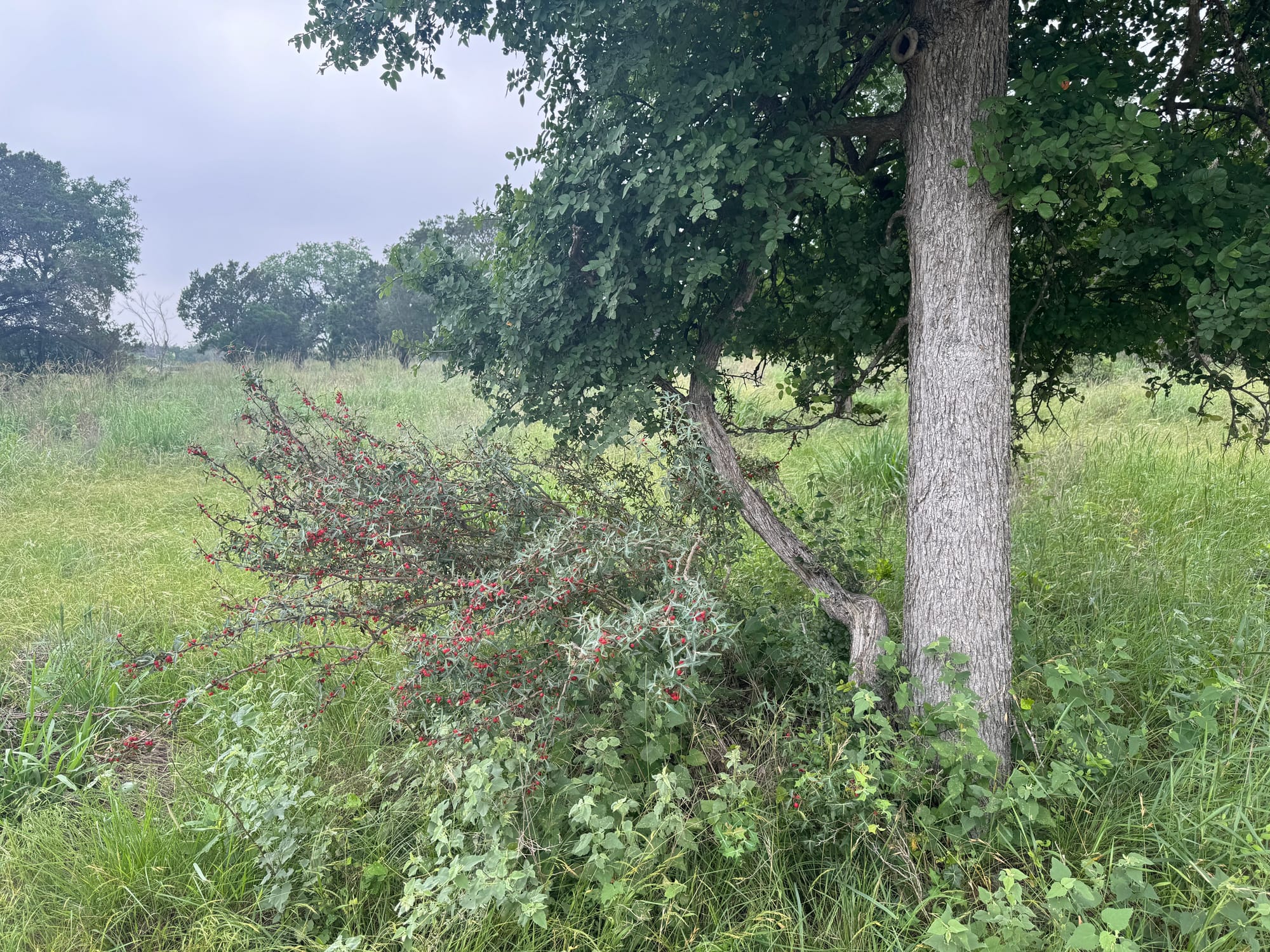
You can plant Agarita underneath your larger shade trees like Live Oaks, Anacuas, Mesquite, Ashe Juniper, or smaller understory trees like your Texas Mountain Laurel, Texas Persimmon, or Mexican Buckeyes.
To fill in space around the Agarita, I’ve planted Chili Pequin and have seen recommendations to plant Scarlet Sage, Turk’s Cap, Pigeonberry, or Barbados Cherry.
- Texas Redbud
- Rusty Blackhaw
- Viburnum
- Bluewood Condalia
- Texas Prickly Pear
- Cenizo
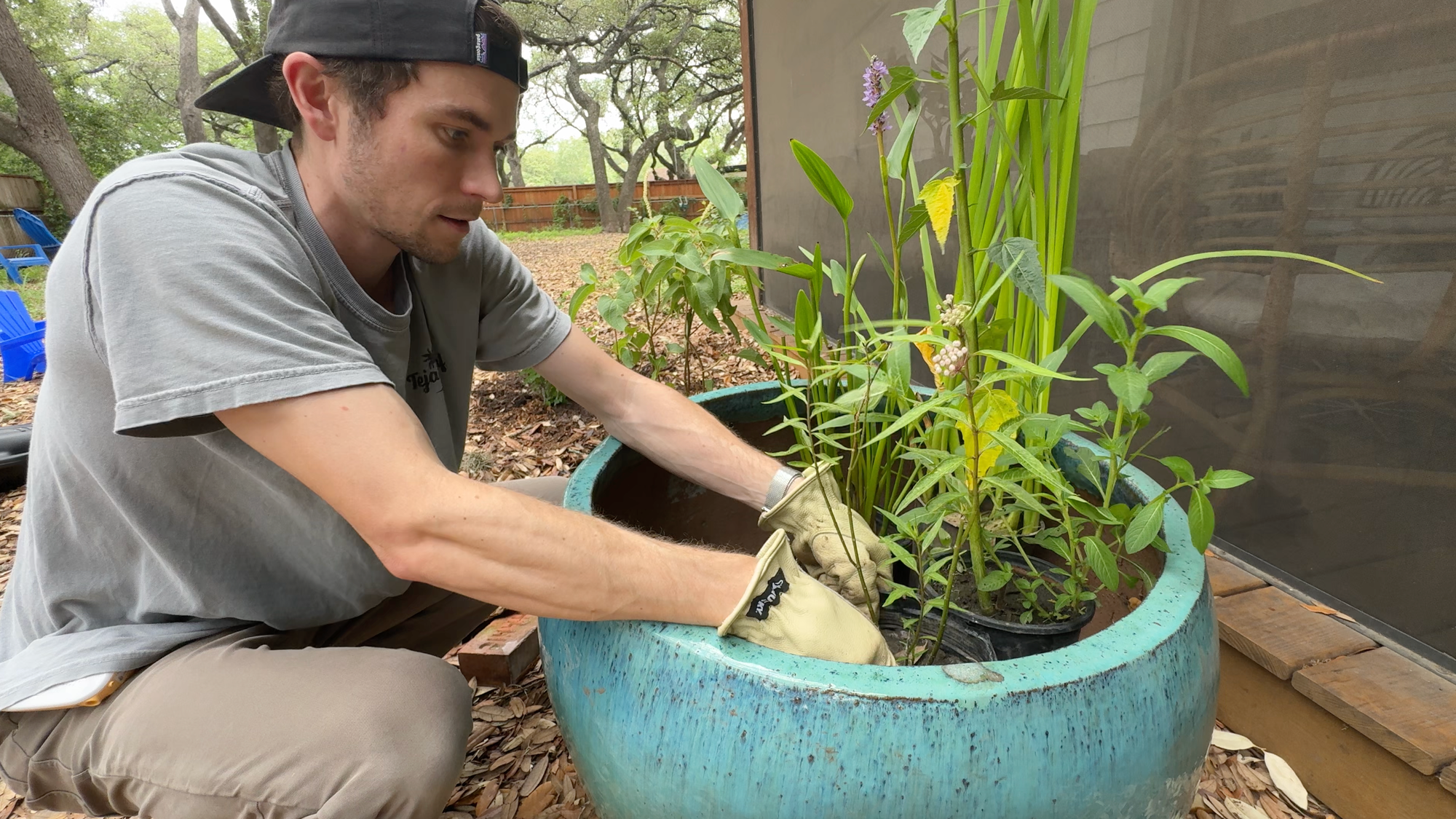
Stop Stressin', Start Planting 🌱
If you want help picking the right plants for your landscape, consider booking a Texas-sized Native Plant or Food Forest consult with me or, having me build a custom plant list for you based on your site and home landscape goals.
LEARN MORE >>>Seasons: What to Expect
Here’s what to expect from an Agarita in your landscape (or our in nature), season-to-season:
🌱 Spring: Agarita is early to bloom in spring. It might in fact be one of the first bloomers you'll notice, along with Texas Mountain Laurels and Texas Redbuds. Agarita's tiny, and often profuse blooms, are yellow and highly fragrant (enjoy!). Following the blooms comes the berries. Berries can hit in mid to late spring, or early summer.
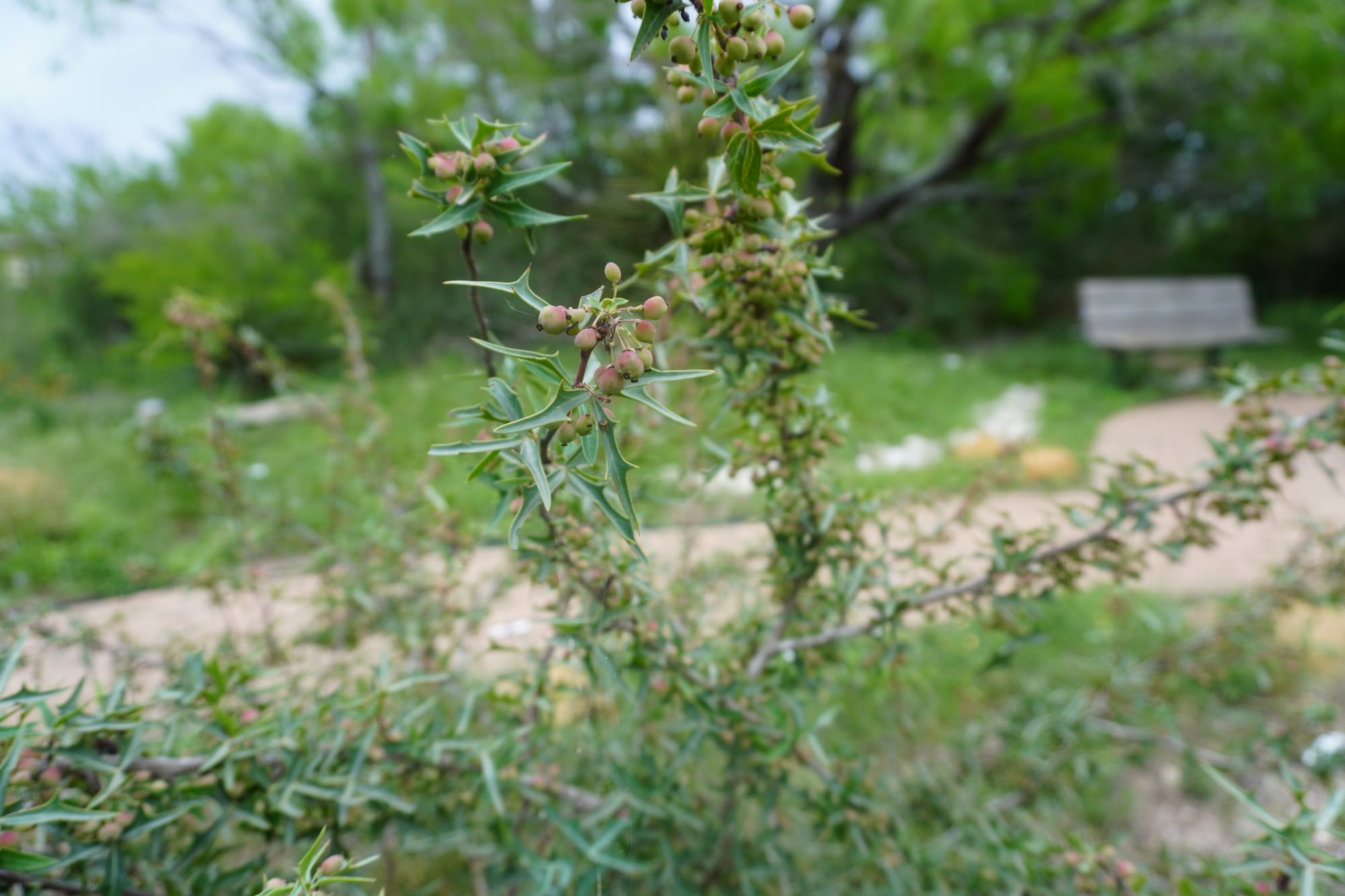
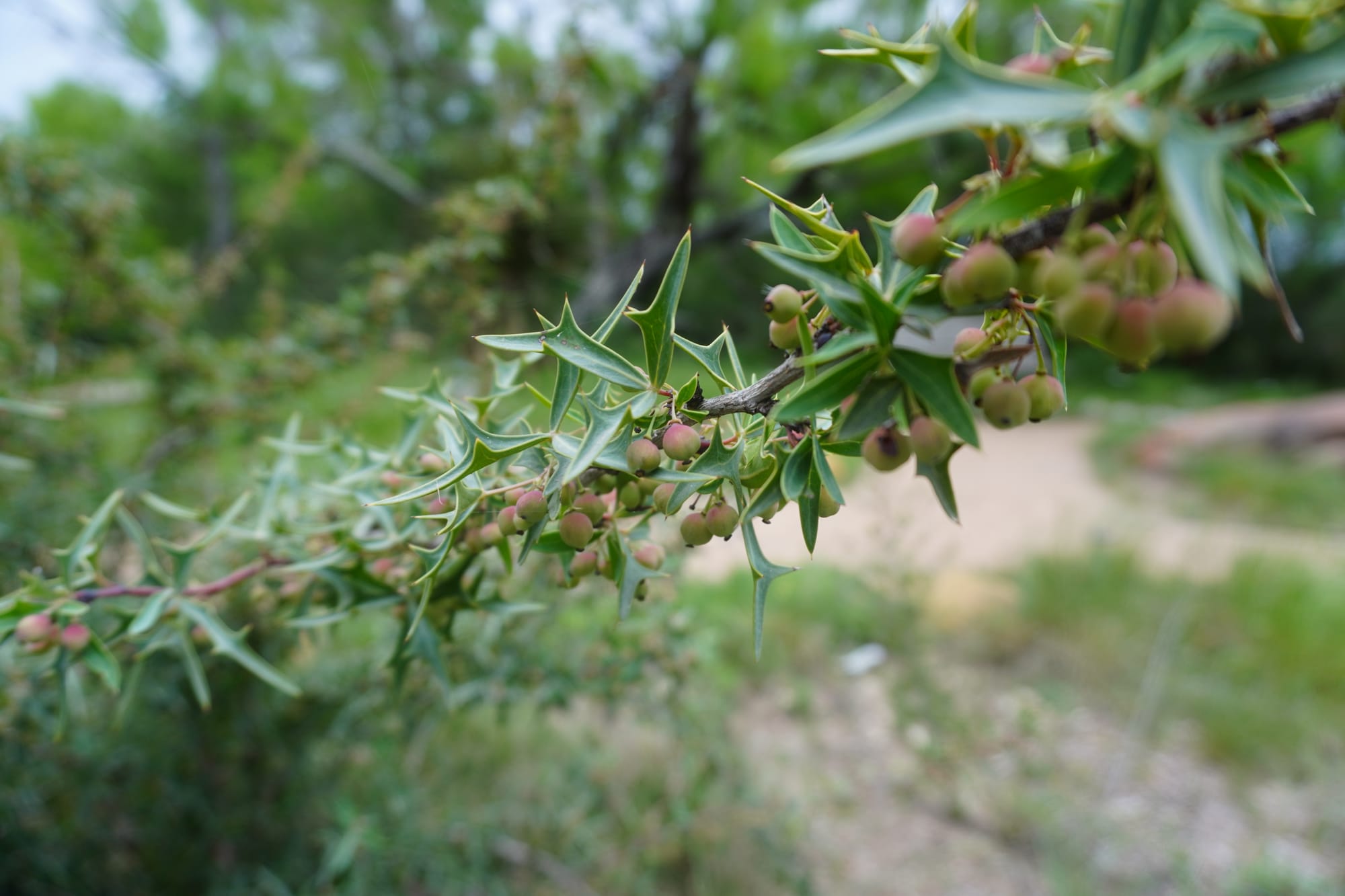

Agarita full of new berries in early Spring and one Agarita (right) flowering in later winter.
☀️ Summer: Depending on the birds or your foraging efforts, you may have some of the bright red Agarita berries still on your plants. Once they are gone, you'll left with a still handsome, grey-bluish evergreen shrub.
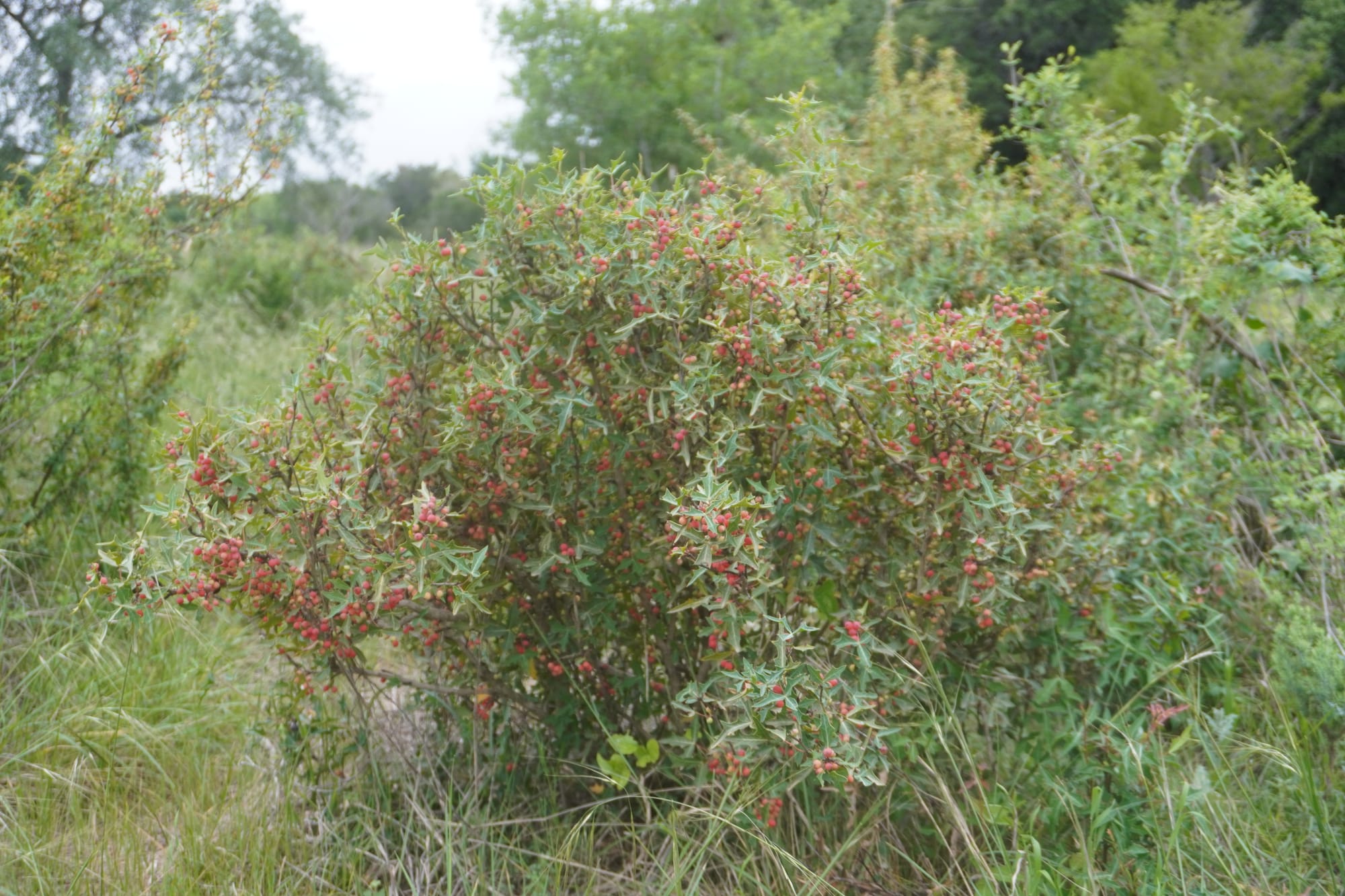
🍂 Fall: Agarita will continue to look very similar through the remaining seasons.
❄️ Winter: In winter, on rare occasions, the Agarita might lose a few leaves, but nothing significant. Late winter, buds will start to appear for Agarita's yellow blooms (and berries!) to follow.



Winter buds starting to emerge on the Agarita | Phil Hardberger Park
Medicinal/Edible Uses:
The Agarita produces small berries in late Spring early Summer that can be made into a jelly (or wine). My smaller Agarita shrubs were cleaned in a week by Northern Mockingbirds, so keep in mind how much you harvest as to ensure the birds visiting your landscape have an adequate food source.
You can eat the berries right off the bush. However, given the prickly nature of the bush, complete the task either with gloves or, as some suggest, lay a bedsheet, blanket, or tarp beneath the Agarita bush and beat it with a stick. Seriously!


The redder they are, the better. Authors of Foraging Texas, Eric Knight, and Stacy Coplin, suggest that the berries are typically best in early summer. Agarita berries might be best made into a jam, something I'll be testing myself soon.
The wood of the Agarita is actually yellow. According to Edible and Useful Plants of the Southwest, by Delena Tull, the wood of Agarita is yellow because of the presence of the akaloid berberine. The wood can be used as a light yellow dye. Tull identified that researche done in China and Korea show that berberine has the potential to treat diabetes, breast cancer, and potentially other diseases, too.
In Foraging Texas, it's mentioned that Agarita bark and root might have significant potential as an antibacterial and antiviral. Clinical herbalist Sam Coffman in Bulverde, Texas, has used it extensively to treat patients.
Propagation:
🌱From Seeds – From my research, growing Agarita from seed is quite difficult and a long process. Growers report that Agarita grown from seed will take a minimum of three years to produce a 5-gallon plant. The seedlings as well seem to be quite particular about their soil conditions. For me, unless you are a very serious and committed grower, I'd pass on propagating Agarita from seed.
✂️From Cuttings – Cuttings seem to be a more viable option for propagating Agarita. Highest success rates are from rooting dormant hardwood cuttings (taken in winter) from the previous year's growth. Cut 5-6 inches in length, apply rooting hormone, and keep under mist.
I plan to experiment with this method this year. I will report back!
Agarita FAQs:
Where Can I Buy an Agarita?
I’ve found Agarita at multiple local nurseries in the San Antonio area. This won’t be the type of plant available at a big box store like Home Depot; check with your local nurseries known to sell native plants.
You can find seeds from Agarita berries online if you’d like to grow plants from seed (although, that's a long timeline).
What is Agarita Good For?
The Agarita offers a few different wildlife benefits; food, nectar for pollinators, and protection. It’s also versatile in the landscape; it can act as a perimeter hedge, has beautiful fragrant early spring blooms, and it won’t drop it’s leaves so it’ll keep it’s shape all year round.
Are Agarita Berries Edible?
Yes! The small berries are sweet, tart, and can be eaten directly off the bush. They are peak ripeness in May to early June.
How Big Does Agarita Get?
The Agarita can get up to 10 ft tall in some conditions! However, it’s average range is ≈3-6ft. It will depend on it’s access to light and soil conditions. The more light and more ideal soil conditions (rocky, dry) the bigger the Agarita can get.
What Birds Eat Agarita Berries?
Songbirds. I’ve personally watched Northern Mockingbirds enjoy the Agarita berries as a snack.
Sources:
Along with my own experience working with Agarita in my landscape and learning from my observations out in Texas' natural places, here are all the books and resources that I consulted in producing this page:
📚 Books
- Edible and Useful Plants of the Southwest: Texas, New Mexico, and Arizona by Delena Tull
- Foraging Texas: Finding, Identifying, and Preparing Edible Wild Foods in Texas by Eric M. Knight and Stacy M. Coplin
- How to Grow Native Plants of Texas and The Southwest by Jill Nokes
- Texas Wildcapes: Gardening for Wildlife by Noreen Damude and Kelly Conrad Bender
- Native Texas Plants: Landscaping Region by Region by Sally and Andy Wasowski
🌐 Websites
- (n.d.). Mahonia trifoliolata. Lady Bird Johnson Wildflower Center. https://www.wildflower.org/plants/result.php?id_plant=MATR3
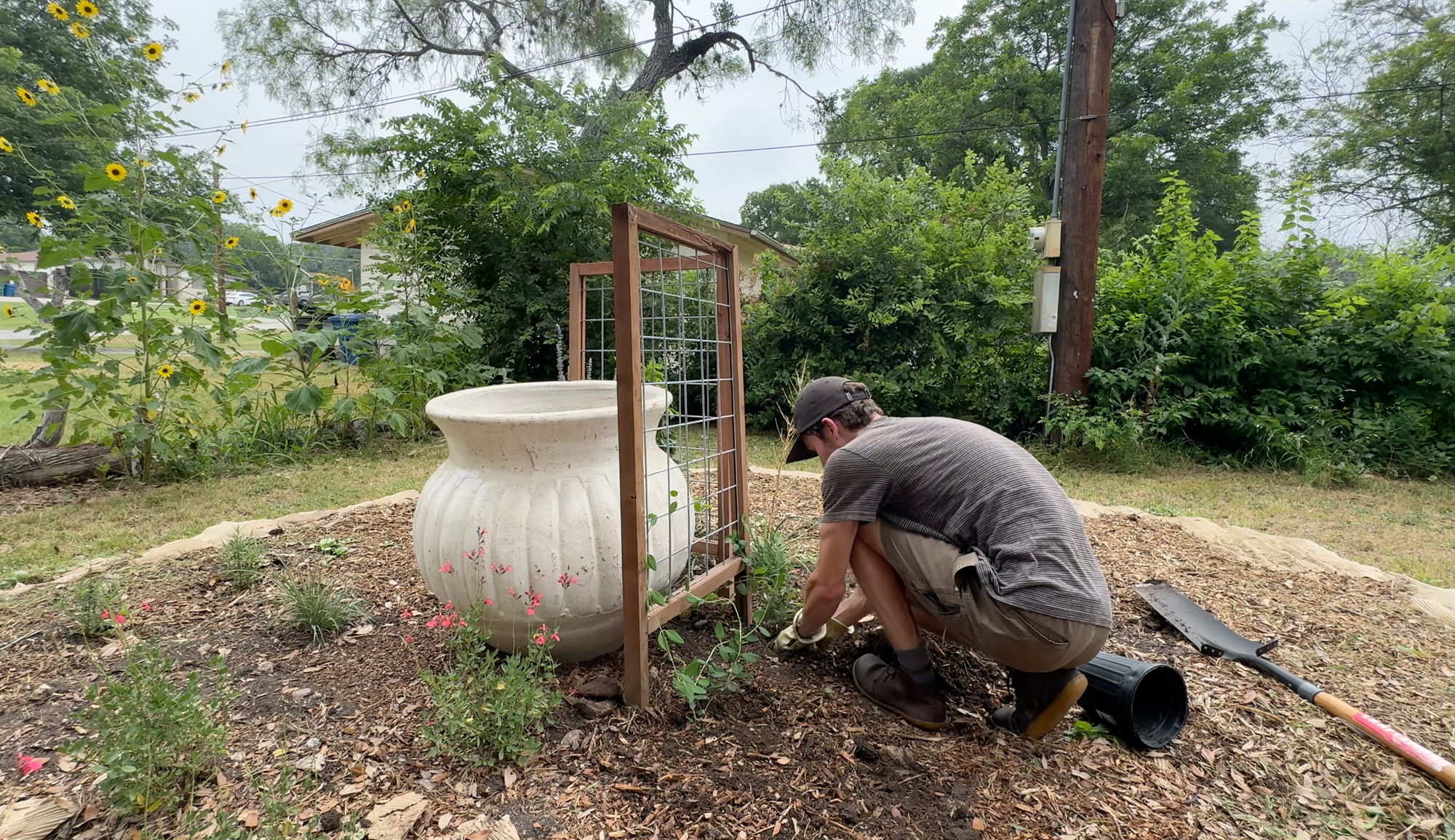
🤠 Book a Texas-Sized Consult
Stop stressing about what to plant and where. Save time and money by booking a Texas Native Plant consult with me (Cory Ames), or letting me build a custom plant list for you and your landscape. 🌱
LEARN MORE >>>
